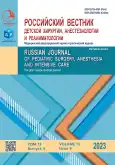Сравнительный анализ результатов мультиспиральной компьютерной томографии с использованием методов цветового картирования и магнитно-резонансной томографии в диагностике острого гематогенного остеомиелита у детей
- Авторы: Поздняков А.В.1, Сварич В.Г.2,3, Лыюров Д.А.2,3
-
Учреждения:
- Санкт-Петербургский государственный педиатрический медицинский университет
- Республиканская детская клиническая больница
- Сыктывкарский государственный университет им. Питирима Сорокина
- Выпуск: Том 13, № 4 (2023)
- Страницы: 503-511
- Раздел: Оригинальные исследования
- URL: https://bakhtiniada.ru/2219-4061/article/view/249860
- DOI: https://doi.org/10.17816/psaic1571
- ID: 249860
Цитировать
Полный текст
Аннотация
Актуальность. Несмотря на то что острый гематогенный остеомиелит считается достаточно хорошо изученным заболеванием, частота диагностических ошибок остается достаточно высокой. Остеомиелит бывает трудно выявить из-за вариабельности и неспецифичности симптомов, физикальных и лабораторных показателей. Ранняя диагностика имеет решающее значение для успешного исхода заболевания, так как несвоевременное лечение увеличивает количество осложнений.
Цель — оценить информативность методов магнитно-резонансной томографии и мультиспиральной компьютерной томографии в диагностике интрамедуллярной фазы острого гематогенного остеомиелита, как его наиболее раннего признака.
Материалы и методы. Тридцати пациентам с подозрением на острый гематогенный остеомиелит были выполнены магнитно-резонансная томография и мультиспиральная компьютерная томография с применением методики цветного картирования и оценкой рентгеновской плотности. На заключительном этапе диагностического алгоритма проводили остеотонометрию. Одновременно производили забор содержимого костно-мозгового канала для проведения микробиологических и бактериологических исследований.
Результаты. В интрамедуллярной фазе острого гематогенного остеомиелита при магнитно-резонансной томографии и мультиспиральной компьютерной томографии в 96 % случаев выявлены признаки отека костного мозга. Чувствительность магнитно-резонансной томографии составила 96 %, так же как и при мультиспиральной компьютерной томографии, однако специфичность была значительно ниже, чем у мультиспиральной компьютерной томографии с применением метода цветового картирования и оценкой рентгенологической плотности, и составила соответственно 67 % против 83 % (p < 0,05).
Обсуждение. В последние годы роль компьютерной томографии в диагностике острого гематогенного остеомиелита у детей получила значительное признание в детской хирургической практике, а использование мультиспиральной компьютерной томографии с применением метода цветового картирования и оценкой рентгенологической плотности в диагностике острого гематогенного остеомиелита у детей стало использоваться относительно недавно. В то же время о высокой информативности мультиспиральной компьютерной томографии в диагностике острого гематогенного остеомиелита сообщалось многими исследователями.
Выводы. 1. Картина интрамедуллярной фазы острого гематогенного остеомиелита по данным магнитно-резонансной томографии и мультиспиральной компьютерной томографии свидетельствует об отеке костного мозга, как его наиболее раннем признаке. 2. По данным настоящего исследования, мультиспиральная компьютерная томография с использованием метода цветового картирования и оценкой рентгеновской плотности обладает высокой специфичностью и может совместно с магнитной резонансной томографией использоваться в качестве основного метода диагностики интрамедуллярной фазы острого гематогенного остеомиелита.
Полный текст
Открыть статью на сайте журналаОб авторах
Александр Владимирович Поздняков
Санкт-Петербургский государственный педиатрический медицинский университет
Email: pozdnyakovalex@yandex.ru
ORCID iD: 0000-0002-1110-066X
SPIN-код: 1000-6408
д-р мед. наук, профессор
Россия, Санкт-ПетербургВячеслав Гаврилович Сварич
Республиканская детская клиническая больница; Сыктывкарский государственный университет им. Питирима Сорокина
Автор, ответственный за переписку.
Email: svarich61@mail.ru
ORCID iD: 0000-0002-0126-3190
SPIN-код: 7684-9637
д-р мед. наук
Россия, Сыктывкар; СыктывкарДенис Алексеевич Лыюров
Республиканская детская клиническая больница; Сыктывкарский государственный университет им. Питирима Сорокина
Email: denis_liurov@mail.ru
ORCID iD: 0000-0002-8818-0055
SPIN-код: 2687-8324
Россия, Сыктывкар; Сыктывкар
Список литературы
- Shamsiev ZhA, Shamsiev AM, Makhmudov ZM. To the question of early diagnosis of acute hematogenous osteomyelitis of bones of the hip joint in children. Pediatric surgery. 2018;22(2):83–88.
- Sazhin AA, Rumyantseva GN. Features of the course of metaepiphyseal osteomyelitis in young children. Tver Medical Journal. 2017;(3):70–72. (In Russ.)
- Lyurov DA, Svarich VG, Рozdnjakov AV. Optimization techniques for early diagnosis of acute gematogennogo osteomyelitis in children. Visualization in medicine. 2020;2(3):13–21.
- Mamatov AM, Abhadylykov ZA, Kamshibekov UA, Boronbaeva EA. Treatment of septic forms of acute osteomyelitis in children. Bulletin of Science and Practice. 2018;4(11):97–100. doi: 10.5281/zenodo.1488116
- Rumyantseva GN, Gorshkov AY, Sergeechev SP, Mikhailova SI. Acute metaepiphyseal osteomyelitis in young children, peculiarities of course and diagnosis. Modern problems of science and education. 2017;(4):41.
- Arnold JC, Bradley JC. Osteoarticular infections in children. Infect Dis Clin North Am. 2015;29(3):557–574. doi: 10.1016/j.idc.2015.05.012
- Eshonova TD. Acute hematogenous osteomyelitis in children. Pediatria n.a. after G.N. Speransky. 2016;95(2):146–152.
- Karmazanovsky GG. Assessment of diagnostic significance of the method (sensitivity, specificity, overall accuracy). Annals of HPB Surgery. 1997;2:139–142.
- Rumyantseva GN, Gorshkov AY, Sergeechev SP, Mikhailova SI. Methods of radial diagnostics in acute metaepiphyseal osteomyelitis. Pediatric surgery. 2019;23(1S3):56. (In Russ.)
- Minaev SV, Filipieva NV, Leskin VV, et al. Radiological methods in diagnostics of acute haematogenous osteomyelitis in children. Doctor.Ru. 2018;(5):32–36. doi: 10.31550/1727-2378-2018-149-5-32-36
- Simpfendorfer CS. Radiologic approach to musculoskeletal infections. Infect Dis Clin North Am. 2017;31(2):299–324. doi: 10.1016/j.idc.2017.01.004
- James DC, Gail JH, Sheldon LK, et al. Feigin and Cherry’s textbook of pediatric infectious diseases. 7th edition. Elsiver, 2014. Vol. 55. Р. 711–727.
- Pugmire BS, Shailam R, Gee MS. Role of MRI in the diagnosis and treatment of osteomyelitis in pediatric patients. World J Radiol. 2014;6(8):530–537. doi: 10.4329/wjr.v6.i8.530
- Lee YJ, Sadigh S, Mankad K, et al. The imaging of osteomyelitis. Quant Imaging Med Surg. 2016;6(2):184–198. doi: 10.21037/qims.2016.04.01
- Dartnell J, Ramachandran M, Katchburian M. Haematogenuos acute and subacute paediatric osteomyelitis. A systematic review of the literature. J Bone Joint Surg. 2012;94-B(5):584–595. doi: 10.1302/0301-620X.94B5.28523
- Mikhailova SI, Rumyantseva GN, Yusufov AA, et al. Methods of radiation diagnostics of acute hematogenous osteomyelitis in children of different age groups. Modern problems of science and education. 2020;(2):148. doi: 10.17513/spno.29711
- Strelkov NS, Razin MF. Hematogenic osteomyelitis in children. Moscow: GEOTAR-Media., 2018. 160 p. (In Russ.)
Дополнительные файлы











